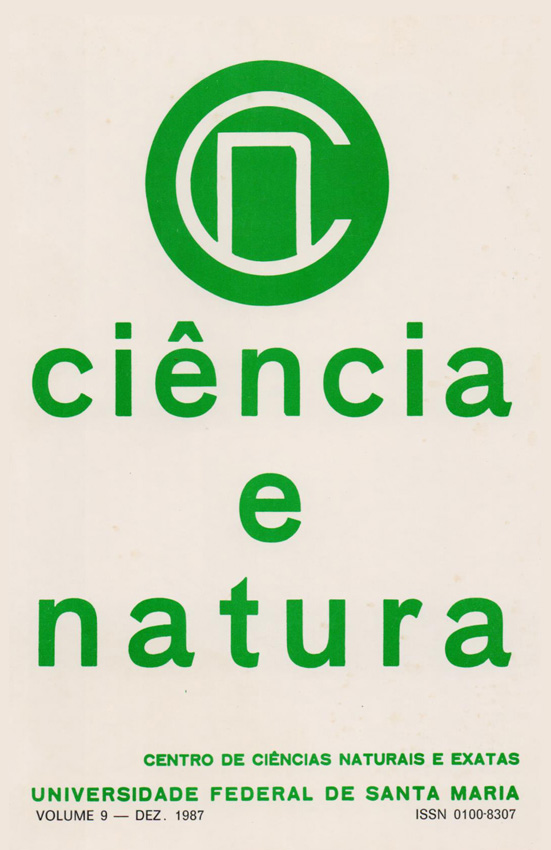Petrography of marbles from Caçapava do Sul, RS, Southern Brazil
DOI:
https://doi.org/10.5902/2179460X25458Abstract
The Caçapava do Sul region, State of Rio Grande do Sul, is characterized by the occurrence of a granitic batholith (Caçapava Granite), that has an outcrop of about 25 by 10 km, oriented North- South. The Caçapava Granite is surrounded by a belt of metamorphites belonging to the Porongos Group, assigned to Upper Precanbrian by RIBEIRO et alii: (1966). Among the metamorphites occur a carbonatic rock body, lens shaped, with clear contacts, interpenetrated by granitic apophises and with an outcrop of about 17 km2. Samples of this rock body were studied by microscopic, difratometry and spectrometry of X ray, electronic microprobe and chemical analyses aiming at identifying and characterizing the carbonatic and silicatic minerals. Through staining techniques it was possible to distinguish dolomite (Do), calcite (Cc) and ferriferous calcite (Ccf). The modal and chemical analysis showed that the carbonatic minerals were more abundant than the silicatic ones being these last ones restricted to of the rock bands. The detected silicatic minerals were the following: talc, tremolite, diopside, forsterite, chlorite and phlogopite. In smaller amounts titanite, apatite and quartz also occur. Serpentine resulting from alterations in the olivine is also very common. The final conclusion with these studies, about the carbonatic rocks, indicate that they are contact impure dolomitic marbles.
Downloads
References
BORTOLOTTO, O.J. Petrologia dos Mármores de Caçapava do Sul, RS. Dissertação de Mestrado. Instituto de Geociências. Universidade de São Paulo. 1986. (Inédito).
CHAVES, F. A simple point-counter for thin section analyses. Am. Miner., 134: 1-11, 1949.
DEER, W.A.; HOWIE, R.A. & ZUSSMAN, J. An Introduction to the Rock-Forming Minerals, Longman. London. 1971.
GIRARDI, V.A. V. Metamorfismo e seus produtos. Curso de Pós-Graduação. Instituto de Geociências, USP. 1979. (Inedito).
HEY, M.H. A new review of the chlorites. Min. Mag. 30: p.277. 1954. (Cit. em DEER et alii, 1977).
HUTCHISON, C. S. Laboratory Handbook of Petrographic Techniques. J. Wiley & Sons. N. York. 1974.
LEAKE, B. E. A catalog of analysed calciferous and subcalciferous amphiboles together with their nomenclature and associated minerals. Geol., Soc. Am. Spec. Paper, 98. 210p. 1968. (cit. em HUTCHISON, 1974).
OLIVEIRA, M.A.F. de - Petrologia das rochas granuliticas da Faixa Paraíba do Sul, Estados do Rio de Janeiro e Minas Gerais. Tese de Livre Docência, UNESP, Rio Claro, SP, 1980. (Inédito).
POLDERVAART, A. & HESS, H. H. Pyroxenes in the crystallization of basaltic magma. Journ. Geol, 59: p.472. 1951. (cit. em. DEER et alii,1977).
RIBEIRO, M.; BOCCHI, P.R.; FIGUEIREDO F., P.M. & TESSARI, R.L. Geologia da Quadricula de Caçapava do Sul, Rio Grande do Sul, Brasil. Div. Fom. Prod. Min., Bol. 127; 232p. 1966.
RIBEIRO, M. Geologia da Folha de Bom Jardim, Rio Grande do Sul, Brasil Dep. Nac. Prod. Min., Div. Geol. e Min., Bol. 247, 142 p. 1970.
WAHLSTROM, E. E. & KIM, O.J. Precanbrian rocks of the Hall Valley Area, Front Range, Colorado. Bull, Geol, Soc. Am., 70: 1217-1244. 1959.
WINKLER, H. G. F. Petrogênese das Rochas Metamórficas. Ed. Edgar Blücher Ltda. S. Paulo. 1977.
WOLF, K. H.; EASTON, A. J. & WARNE, S. Techniques of Examining and Analysing Carbonate Skeletons, Minerals and Rocks. Elsevier Publ. CO. Amsterdam, p. 253-341. 1967.
Downloads
Published
How to Cite
Issue
Section
License
To access the DECLARATION AND TRANSFER OF COPYRIGHT AUTHOR’S DECLARATION AND COPYRIGHT LICENSE click here.
Ethical Guidelines for Journal Publication
The Ciência e Natura journal is committed to ensuring ethics in publication and quality of articles.
Conformance to standards of ethical behavior is therefore expected of all parties involved: Authors, Editors, Reviewers, and the Publisher.
In particular,
Authors: Authors should present an objective discussion of the significance of research work as well as sufficient detail and references to permit others to replicate the experiments. Fraudulent or knowingly inaccurate statements constitute unethical behavior and are unacceptable. Review Articles should also be objective, comprehensive, and accurate accounts of the state of the art. The Authors should ensure that their work is entirely original works, and if the work and/or words of others have been used, this has been appropriately acknowledged. Plagiarism in all its forms constitutes unethical publishing behavior and is unacceptable. Submitting the same manuscript to more than one journal concurrently constitutes unethical publishing behavior and is unacceptable. Authors should not submit articles describing essentially the same research to more than one journal. The corresponding Author should ensure that there is a full consensus of all Co-authors in approving the final version of the paper and its submission for publication.
Editors: Editors should evaluate manuscripts exclusively on the basis of their academic merit. An Editor must not use unpublished information in the editor's own research without the express written consent of the Author. Editors should take reasonable responsive measures when ethical complaints have been presented concerning a submitted manuscript or published paper.
Reviewers: Any manuscripts received for review must be treated as confidential documents. Privileged information or ideas obtained through peer review must be kept confidential and not used for personal advantage. Reviewers should be conducted objectively, and observations should be formulated clearly with supporting arguments, so that Authors can use them for improving the paper. Any selected Reviewer who feels unqualified to review the research reported in a manuscript or knows that its prompt review will be impossible should notify the Editor and excuse himself from the review process. Reviewers should not consider manuscripts in which they have conflicts of interest resulting from competitive, collaborative, or other relationships or connections with any of the authors, companies, or institutions connected to the papers.






